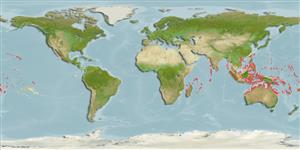Common names from other countries
Environment: milieu / climate zone / depth range / distribution range
بوم شناسي
دريايي وابسته به آب سنگ; غير مهاجر; تغييرات عمق 0 - 20 m (Ref. 9710), usually 2 - 15 m (Ref. 37816). Tropical; 26°N - 25°S
Indo-Pacific: East Africa to Mangaréva, Tuamoto Islands and the Hawaiian Islands, north to Taiwan; throughout Micronesia.
Size / Weight / سن
Maturity: Lm ? range ? - ? cm
Max length : 8.5 cm SL جنس نر / بدون خواص جنسي; (Ref. 9710)
خارهاي باله پشتي (کل): 10; شعاع نرم باله پشتي (کل): 12; خارهاي باله مخرجي 3; شعاع نرم باله مخرجي: 6. Irregular dark bars on body which may be broken into spots; 2 narrow diagonal bars on cheek; opercle and base of soft dorsal with large ocellated black spot (Ref. 5469).
A secretive species remaining in or near interstices of rock, coral, or rubble (Ref. 2334, 58302). Moderately common in seaward reefs in areas exposed to moderate surge or currents (Ref. 2334). Feeds on small crustaceans (Ref. 89972). Benthic (Ref. 58302). Minimum depth reported from Ref. 30874.
Life cycle and mating behavior
بلوغ | تولید مثل | تخم ریزی | تخم ها | Fecundity | توزاد ( لارو)
Randall, J.E., G.R. Allen and R.C. Steene, 1990. Fishes of the Great Barrier Reef and Coral Sea. University of Hawaii Press, Honolulu, Hawaii. 506 p. (Ref. 2334)
وضعيت در فهرست قرمز IUCN (Ref. 130435)
CITES (Ref. 128078)
Not Evaluated
خطر برای انسان ها
Harmless
استفاده انسانی
آكواريوم: تجاري
اطلاعات بيشتر
اسامي عاممترادفسوخت و سازشکارچیانسم شناسي بوم زيستيتولید مثلبلوغتخم ریزیFecundityتخم هانمو تخم
مراجعآبزي پرورينمايه آبزي پرورينژادهاژنتيكElectrophoresesوارثبيماري هافرآوریMass conversion
ابزارها
گزارش های ويژه
بارگيری XML
منابع اينترنتي
Estimates based on models
Preferred temperature (Ref.
115969): 25.2 - 29.3, mean 28.4 (based on 2558 cells).
Phylogenetic diversity index (Ref.
82804): PD
50 = 0.5312 [Uniqueness, from 0.5 = low to 2.0 = high].
Bayesian length-weight: a=0.01585 (0.00637 - 0.03944), b=3.01 (2.79 - 3.23), in cm Total Length, based on LWR estimates for this (Sub)family-body shape (Ref.
93245).
Trophic level (Ref.
69278): 3.5 ±0.6 se; based on size and trophs of closest relatives
Fishing Vulnerability (Ref.
59153): Low vulnerability (10 of 100).
